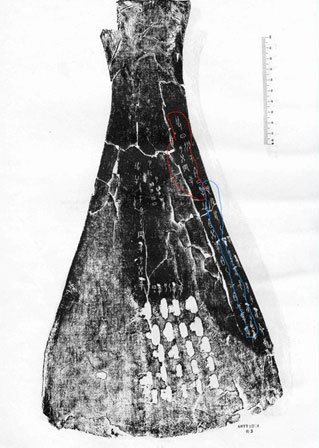Ancient Chinese were knowledgeable about the epidemic 3,000 years ago
The inscriptions on the bones, shells and shells of excavated animals show that the Chinese people have been familiar with the disease since ancient times.
An expert in writing on the bones of an archeology at the Chinese Academy of Social Sciences, Song Zhenhao, said that during the Shang Dynasty (1600 to 1046 BC) when an epidemic was raging, officials Thuong had applied many measures to prevent the epidemic, while residents of this dynasty had to invite the priests to come to perform the ceremony to ward off evil spirits.

The inscription on the bones of ancient China.
The inscription on the bone , also called Giap text , is the ancient Chinese language named for the characters carved on turtle shells and animal bones. This is a primitive form of Chinese characters and is the oldest fully developed characters in China.
One of the best examples is the cow bone fragment found at a Shang Dynasty relic in An Duong City in Henan Province, central China. On this piece of bone is engraved with some ancient writing saying that during the plague, many sacrifices were held to pray for disaster. The plates also contain records of preventive and curative measures such as isolation, acupuncture, wormwood, and so on. This is arguably the first record of the disease situation in ancient China.
According to expert Song Zhenhao, up to now, more than 50 types of diseases have been recorded in the texts engraved on bones and shells, and apricot shells excavated in China. By examining ancient lines, the expert concluded that "the health sector was at a high level" at that time and that the Chinese were knowledgeable about diseases and infectious diseases more than 3,000 years ago. .
- Doctor "ahead of his time" Wu Lien-teh - who stopped the pandemic pneumonia more than a century ago
- 9 evil epidemics in human history
- 6 incredible 'masterpieces' make the whole world 'crouch' in front of ancient Chinese people
- Is the Chinese script 8,000 years ago?
- Discovered a thousand year-old grave in China
- Chinese farmers use a 300-year-old ancient sword to cut vegetables
- Chinese ancient tomb packing 30 tons transferred to the laboratory
- Evidence of Chinese silk production from 8500 years ago
- Extremely precious series of photos about China 100 years ago
- Found ancient Chinese musical instruments
- Excavating an ancient tomb containing an intact male human body suspected of being an ancient Chinese aristocrat
- Ancient tomb 2,000 years next to the silk road on the sea
- 10 amazing items with ancient Chinese words surprise you
- Are the ancestors of Chinese people from ancient Egypt?
 Discovered an ancient centipede fossil 99 million years old
Discovered an ancient centipede fossil 99 million years old Discovered bat-like dinosaurs in China
Discovered bat-like dinosaurs in China Discovered a 200-year-old bronze cannon of the coast
Discovered a 200-year-old bronze cannon of the coast Discover 305 million-year-old spider fossils
Discover 305 million-year-old spider fossils